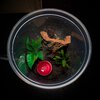regalpaws
Arachnoknight
- Joined
- Mar 10, 2022
- Messages
- 244
I've been doing some research on this species and I've read to water the substrate and let it dry out completely between waterings. But Im not finding too much info on this species and was wondering how everyone is keeping them and what success you're having in your husbandry? To be more specific, what size arboreal enclosures are you keeping your 1" slings in, and info on watering down the substrate and how often. Kinda keep it like an A. avicularia? Thanks so much!
Last edited:



